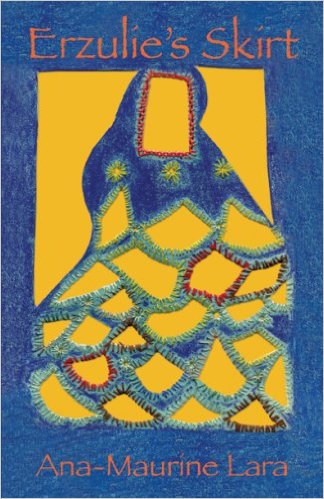 Erzulie’s Skirt
Erzulie’s Skirt
by Ana-Maurine Lara
RedBone Press. 242 pages, $15.
SET IN THE DOMINICAN REPUBLIC, beginning some time after the dictator Trujillo came to power in1930, this book tells the story of two women, their separate childhoods, and their lives together both in the country and in the city of Santa Domingo.
The first girl, Miriam, is the daughter of Haitian parents. Although she was born in the Dominican Republic, she looks Haitian (darker skinned) and thus carries the burden of her ancestry. She is never considered a citizen of the Dominican Republic. Her parents live and work on a sugar plantation on the Dominican side of the borderlands. She’s the youngest and the only surviving child, her six older siblings having been killed during Trujillo’s 1937 massacre, in which border people were slaughtered with clubs and machetes. Miriam is thus born to a mother who is near the end of her childbearing years and to a father who’s nearly too old to work. They tell Miriam that a Haitian working in their situation is nothing more than a slave. The girl stays on the plantation until she meets a boy who impregnates her, and they run away to the city to live together. The second girl, Micaela, is born in the city of Santa Domingo where her brothers go to school, and she stays at home at her mother’s insistence to help keep house. When Micaela’s two-year-old brother drowns while in her care, she is cast out of her home to fend for herself. By the time the girls meet, Miriam and her infant son have been abandoned by the boy from the plantation. The two girls strike up a friendship that eventually turns into a devoted lifetime relationship.
Faith plays a central role in these women’s lives. Present here are the rituals, the mystery, and the ghostly presence of gods and goddesses as well as departed ancestors, who appear before the women and sometimes inhabit their bodies. There are some references to Catholicism; however, the dominant belief system is Voodoo. The name in the book’s title, Erzulie, is a sea goddess. In Santa Domingo, Miriam and Micaela live in the barrio, in a shack with a tin roof and a dirt floor, where the nights are hot and sweaty and mornings bring cold rainwater showers as they prepare to leave their shack for a long day of work. The young women devote themselves to the business of survival, which becomes increasingly difficult when soldiers begin to make nightly raids to seek out and kill Haitians. Then Micaela remembers that when she was a child, her American aunt told her that no one ever goes hungry in New York. So the lovers make a plan to escape. They find a woman who arranges such things and begin to save 600 dollars to pay for their passage on a boat. To them, this is an exorbitant figure, but they see America as a chance for a better life, and in time, through great sacrifice and hard work, they have the fee.
Erzulie’s Skirt is a compelling and powerful story. Ana-Maurine Lara finds beauty in poor surroundings and hard work. Micaela’s lover Miriam smells of sunshine and dirt. Men play dominos and drink beer under shade trees. Scents of coffee dance through the air. Nights, Trujillo’s men come looking for Haitians. Mornings, smoke from fires and gunfire rises from the broken soul of the barrio. Between chapters Lara also weaves short vignettes about Ifé, a woman who tells the tale of ghost men who come to her village, burning it down and taking her and her people on a trip across the ocean, which seems to parallel the trip of Miriam and Micaela while telling the tale of their ancestors.
A generally well-written book, Erzulie’s Skirt’s stylistic flaws tend to stand out in stark relief, notably its occasional clichés. After almost dying in the shark-infested ocean and then watching Miriam’s young son drown, the women find themselves as slaves in a bordello in Puerto Rico, and we read: “Sometimes bad things happen to good people.” But despite the inevitable missteps of a first-time novelist, Erzulie’s Skirt is a powerful story that the reader will not soon forget. It’s a book that challenges our North American complacency, finds beauty in a hard life full of bigotry and poverty, and paints a portrait of a love that soars from the physical to the spiritual; it’s a book that’s well worth reading.






